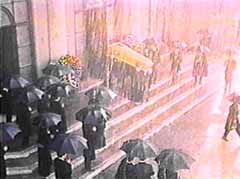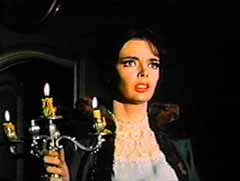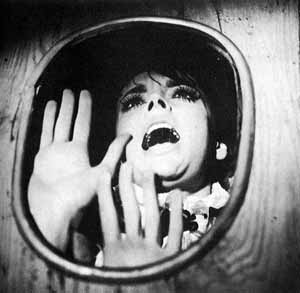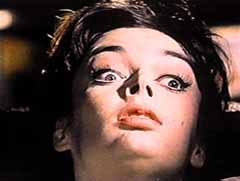|

The funeral scene from
The Horrible Dr. Hichcock.
In its initial review the Monthly Film Bulletin was amused by the movie's play with familiar Alfred Hitchcock film conventions, which for them, along with the humorous anglicized names, indicated a lively sense of humor at work. From Rebecca comes the basic "haunted bride" plot, complete with first wife's portrait and conspiratorial housekeeper. Suspicion's poisoned glass of milk is a direct quote. The rainy funeral is visually reminiscent of a scene in Foreign Correspondent. Most telling is the very Vertigo-like color wash stylization that heightens Hichcock's delirium: a comparison of the obsessive romantic/sexual agendas in The Horrible Dr. Hichcock and Vertigo suggests a more serious thematic relationship between the films than the MFB's "camp parody" conclusion would admit9. There are similarities in the obsessive manias of Scotty Ferguson and Bernard Hichcock that would seem to beg further investigation. Even a cursory analysis reveals that Freda's lowly horror film goes far beyond simply imitating the master of suspense, to propose a radical sexual theory of its own.
Bernard Hichcock's outrageous sexual manipulation of wives Margaretha and Cynthia, like Scotty Ferguson's obsession, is an expression of the masculine drive for an unattainable sexual ideal. This selfish and often destructive mania is easily recognizable, even in contemporary American culture. There is at present a booming trade for mail-order brides from poor developing countries, chattel for men presumably seeking cooperative women uncomplicated by "liberal" American ideas. Is that not equally as chilling as Hichcock's scheme? Many of these men presumably seek compliant sex partners who can be dominated completely--is that not Hichcock's goal? Hitchcock's desire is for the perfect love object, not a companion. And his personal solution carries a certain logic. Would not a corpse for a lover be the perfect non-complaining, totally compliant partner?--an object, a victim, a scapegoat, a passive receiver of affection and abuse, one incapable of spoiling the selfishness of the sexual act with an agenda of its own? It's an ugly concept, but a completely believable one.

The inquistive Cynthia roams the estate.
The Horrible Dr. Hichcock transcends its exploitative title by presenting a bizarrely accurate assessment of sexual alienation. The strange irony is that Hichcock's relationship with his first wife Margaretha is, up to a point, "conventionally conservative"--i.e., the male has the active desires, and the female role is to be willing to indulge them. One doesn't have to be a Victorian to understand the sexual politics at work. Their bizarre game in the secret black velvet "love room" also makes logical cultural sense. With the advent of anesthesia, Victorian childbirth became the exclusive business of male doctors. Because the ideal female was supposed to be sheltered from such unpleasantness, it was assumed she would welcome the opportunity to not even be a conscious participant in the event. Under those conditions it would seem to follow that women consenting to sleep through the animalistic, painful, and messy experience of childbirthing, might also opt out of having to be present for the messy, animalistic and often humiliating sex experience as well. After all, this was a society where women were supposed to want sex not for themselves but only as a way of pleasing their husband/masters. The brief glimpse we are given of the doomed Margaretha shows her an avid participant in her hubby's "funeral" game, radiant in the selfish/unselfish knowledge that she and she alone can help him reach his sexual ideal. Cannot women identify with her unconditional surrender to the will of her mate? When does compliant devotion become sexual slavery?
Margaretha's return from the grave introduces a second relationship-based dynamic, a bald lift from Rebecca but distilled here to its essence. As competitors for Bernard's affections, Cynthia and Margaretha seem to function even more obviously as possessions of matrimony, as objects and not women. Before, Margaretha surely considered her domestic relationship a viable one: he fulfilled her needs, she his. Now, transformed by the serum (and/or a premature burial) into an insane hag, she has become a Dorian Gray-like personification of the sick truth of her marriage. The only communication between these two women is Margaretha's vicious gloating over the fact that Bernard has chosen her over Cynthia. Only one of them is a knowing partner in her husband's game, but neither is anything more than a sexual pawn in an equation that values only Bernard's needs and desires. How can true honesty be achieved between beings with alien sexual agendas, conditioned from childhood to entice and possess the other through deception? After all, no matter what either wife accepts about the extent of his obsession, neither satisfies Bernard's "forbidden desires," which are finding expression elsewhere--on the job, in the neighborhood cemetery ... those pesky perverted men, anyway!--always pursuing sensation, and not relationships! In her dog-like consent to "the game," Margaretha will never know her husband's desires for the tyranny they truly are. Cynthia's one unwilling experience in "the game," apparently with insufficient serum to render her completely unconscious, creates a macabre situation that rather nastily compares loveless matrimonial sex to surgery without anesthesia! The real horror in the film lies in the crimson spectacle of the helpless Barbara Steele experiencing the full extent of her husband's secret rapture--visualized when his horrifying face, engorged and distorted, materializes demon-like from behind the black lace of her four-poster canopy. That terrifyingly unexplainable bloated apparition, in universal terms, represents the menacing sexual stranger that, to a woman in doubt, any male can suddenly resemble.
page 2 of 2
 
Go to notes.
© 1997 Glenn Erickson
Glenn Erickson is a working film editor and an amateur "film detective." He runs
a Web site column for MGM Home Entertainment called MGM Video Savant that
answers consumer mail and discusses video and film history, formats, and minor
mysteries.
Italian Horror Menu page
Italian Horror: A Brief Introduction
Mario Bava: The Illusion of Reality
Mario Bava's Rabid Dogs
Mario Bava Biography
The Horrible Dr. Hichcock
The Devil's Commandment 
Castle of Blood 
Nightmare Castle
The Bloody Pit of Horror 
Italian Horror in the Seventies
Suspiria
Italian Horror Web Links
Photo credits: Silent Scream and Sinister Cinema
|






